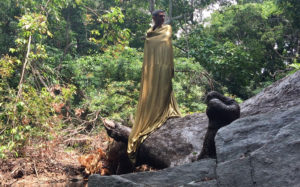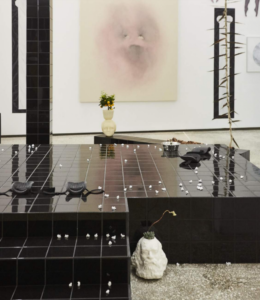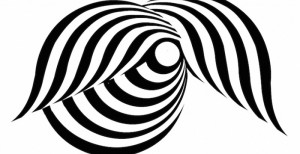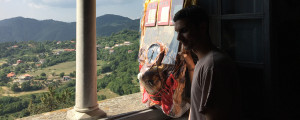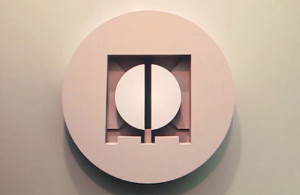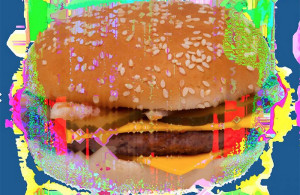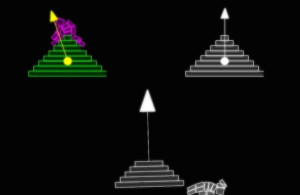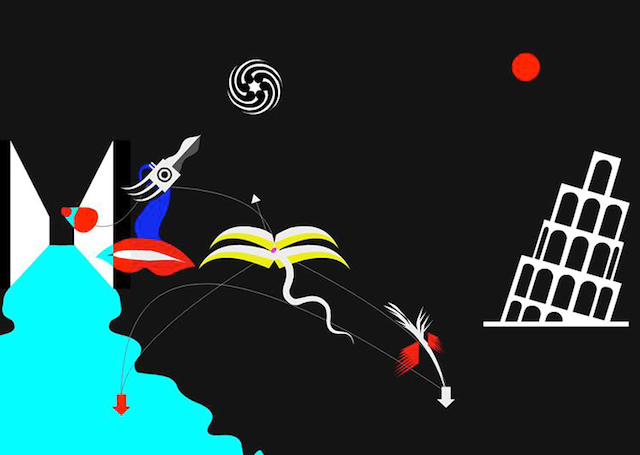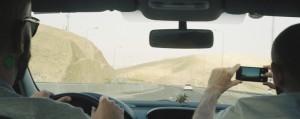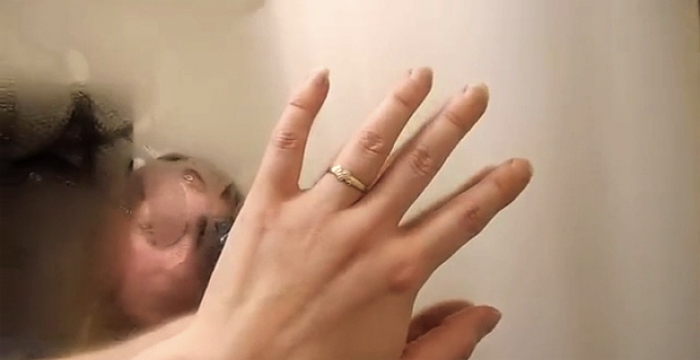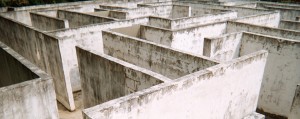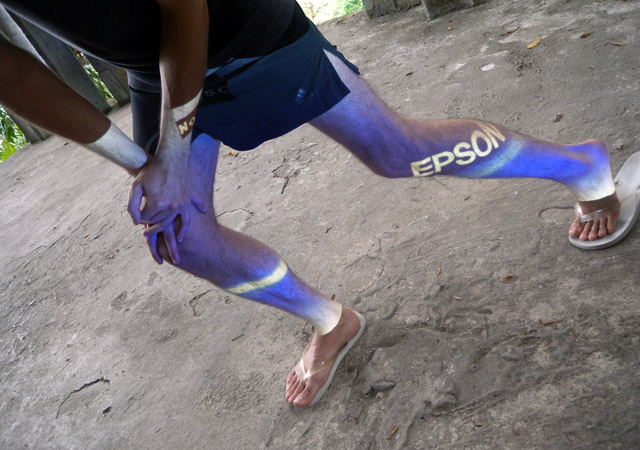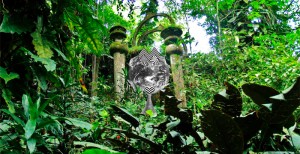Artist, writer and architect Andreas Angelidakis shares his experience of Eternal Internet Brother/Sisterhood, organised by artist Angelo Plessas, taking place in Sigiriya, Sri Lanka, from October 10 to 18.
I was ambivalent about joining the 5th Eternal Internet Brotherhood/Sisterhood (#ETINTERBRO5). I had a lot of work to do and was planning the move to a new apartment after ten years of staring at the sea. But could I miss spending a week in the jungle in Sri Lanka, living in a treehouse? I went to I Ching divination online to tell me what to do. The hexagram that came back said:
FELLOWSHIP WITH MEN in the open.
Success.
It furthers one to cross the great water.
The perseverance of the superior man furthers.
It was a done deal, I booked my ticket.
Angelo and I leave Athens around midnight, landing in Doha first, the Qatar airport is vast and empty. I recognize the Swiss chairs: ‘don’t they cost something like 1000 euros each?’ It’s a sea of these chairs, in every color of expensive leather imaginable. The next morning in Sri Lanka’s capital Colombo, just after the passport control, we arrive at the shores of duty free ‘hope’ appliances (that was a typo, but I’ll leave it, I meant to write ‘home’). Rows, and rows of washing machines and fridges are the first to greet you when you land. Later we find out that these white goods aren’t addressing us but the Sri Lankans who arrive home after having worked in the United Arab Emirates or Europe; affordable luxuries for returning workers can buy for their relatives. We cross and head over to a kiosk to top up our cell phone, 5GB of mobile internet.
Heaven together with fire:
The image of FELLOWSHIP WITH MEN.
Thus the superior man organizes the clans
And makes distinctions between things.

The next day, we gather outside our small hotel in Colombo. It is the first time we meet as a group, 19 of us boarding a flight to Dambulla, the main village of Sigiriya, with a quick stop at the Goethe Institut for a thank you for their support. Finally we’re outside Dambulla, in a kind of endless suburbia made up of one long village of grocery stores and mirror panel shacks, selling something. You can see traces of earlier British colonial rule, not so much in the architecture but in the school uniforms of children waiting to be picked up by their parents on motorcycles. The place that Angelo picked for this edition is a compound called Back of Beyond, in the historic Sigiriya. I can’t help interpreting the village name into the Greek word ‘sigiriya’, which translates to something like ‘coincidence’. We are heading toward a coincidence in the jungle. I keep looking at the time, because we’d read online that check-in before 6pm is preferred to avoid the elephants. They like to come out at night when it’s cooler. We arrive when it is already pitch dark, prime elephant time.
Nine at the beginning means:
Fellowship with men at the gate.
No blame.
Where we arrive is not there, really. There seems to be nowhere to stay, just a pond and a lot of trees. We’re guided to the dinner area where the Back of Beyond team are waiting with some drinks. The tree houses have no walls, just a platform and a roof on a tree. The group self-organizes into subgroups, each in their own elevated space. Angelo and I pick the one place that isn’t really for rent, it can only hold two people and is the hardest to climb, three stories of rickety ladder in the jungle.
As the days go by, we gradually find our routine. We visit archaeological sites, the incredible Buddha caves and the post-metabolist Sigiriya Museum, where artist Jagath Weerasinghe gives us precious insight into the history of Sri Lanka. Project proposals begin surfacing, because jungles bring inspiration. Artist Luca Pozzi, teaming up with muralist Ruwangi Amarasinghe and Kris Lemsalu heads up to the Pidurangala rock — with its ancient monastery and round boulder — to perform laser drawings on a light-sensitive kimono. I stay back at the treehouse, studying the books we bought at the museum bookshop. Luca and company bring back astounding images of Kris on top of the ancient rock, looking like an ethereal being, wearing the fabric while Ruwangi drew on her, the sun collaborating by setting. I can’t help but make a connection to the text I’ve been reading, Sigiriya, Art of the Sunset, about the murals on the side cave of the rock, depicting women sitting on clouds. It explains that these were not humans but rare star constellations. I notice a tattoo on Ru’s arm, which she explains is its own rare sequence of stars. Now it makes sense that Luca insisted they perform at sunset. It was all a strange ‘sigiriya’, a coincidence we couldn’t avoid.
Six in the second place means:
Fellowship with men in the clan.
Humiliation.
Another book I picked up at the museum is The Message of the Peacock. It speaks about ‘Cloud messaging’, a tradition of poetry called Meghadūta that comes in the form of a dispatch. You would ask an element of nature to deliver it to a loved one. A peacock, a monkey, or, of course, a cloud would travel carry this message, but the point of the verse is to describe the places between you and them. Is this some ancient form of Facebook messenger? Has my overused emoji seen places as amazing as what the peacock of this poem would have? Why I am suddenly interested in poetry? It all makes sense when Imaad Majeed suggests we collaborate on a project. I had told him what I do on our first night at Back of Beyond, using buildings as actors in storytelling. Imaad is a poet and a peaceful Tamil activist, and he’s fascinated by the story of the mosque in Dambulla, threatened with demolition by the Monks of the Golden Temple.
Nine in the third place means:
He hides weapons in the thicket;
He climbs the high hill in front of it.
For three years he does not rise up.
Who knew that Buddhists could be violent? Our collaboration makes sense because I’m an architect interested in a poem, and Imaad is a poet interested in a building. After an afternoon at the Buddha cave complex and the ultra glamorous Golden Temple of Dambulla, we split up from the group for a discreet visit to the tiny mosque across the street. Not so much a building, but a shack assemblage, the Imam Imam explains that they are indeed being forced out but the final decision is pending. I pretend to pray, and follow Imaad’s lead, pointing my index finger to Mecca as my sweaty forehead touches the directional carpet on the floor. The next morning, back at the Back of Beyond compound, Imaad performs his ablutions, stepping onto a little raft and paddling out to the center of the lotus pond. There, he scribbles a modified version of the Meghadūta poem on the water as the sisters and brothers of #ETINTERBRO5 watch from the shore. Is the little mosque asking the rain to deliver a plea of help to the ancient rock of Sigiriya, and is Imaad the sender or the messenger? Would I be the recipient or the translator of this message into architecture? When I Google ‘Meghadūta’ to check the correct spelling, my Safari browser asks me if I’m looking for ‘Metadata’, and I wonder if that’s all it comes down to.
Nine in the fourth place means:
He climbs up on his wall; he cannot attack.
Good fortune.
At night, we are all sitting at the Sri Lankan artists’ treehouse, which is the best one really, but in being the cautious technocrat, I wonder if it would carry all our weight. Artist Candice Jacobs pulls out three tarot cards drawn by a fellow witch in California. Candice is softly spoken and gentle, and whispers that the first card I picked, the Emperor, means people look to me for support. I anxiously remind everyone that we are all too heavy for the treehouse and it’s going to collapse. The second card is the Magician, which might be interpreted that I’m making something out of nothing. I slip quietly into a haze as I listen to Candices’ meditation mantras, mixed in with the sound of raindrops and wild birds.
Nine in the fifth place means:
Men bound in fellowship first weep and lament,
But afterward they laugh.
After great struggles they succeed in meeting.
The next morning, Kris and Danushka Marasinghe slow dance in the little river that crosses the Back of Beyond compound full of fish that eat dead skin to the sounds of Kylie Minogue and Nick Cave singing ‘Where the Wild Roses Grow’. We cross the rainforest where Isuru Kumarasinghe and Dinelka Liyanage have installed sounds for us to listen to, or maybe the jungle is listening to the beeps and interfaces, and we are just there to witness the exchange that is the Eternal Internet Brotherhood/Sisterhood.

The 5th Eternal Internet Brother/Sisterhood.
Danushka places his giant SLR camera in front of his face, and begins talking about how it is hard to look into anybody’s eyes and have an intimate conversation. How the viewfinder would help him break down the distance of social conventions. I look through the camera lens at his face, struck by how intimate a jungle can be.
Jan Moszumanski, in yellow facepaint performs a ritual on top of Sigiriya Rock, as a little snake slithers by. Angelo rushes to capture it on video, and I wonder how far he’s come from the days when he would freeze at the sight of a reptile.
An #unknownartist moves like a friendly ghost through our compound, tying branches around branches, plants onto trees, making shelving and coconut walls, and even little washbasins for the birds. We discover these things daily and wonder if the legend of the aging female minimalist artist who disappeared one night in the jungle were true. Is she still alive or is her spirit becoming our #ETINTERBRO sister?
Nine at the top means:
Fellowship with men in the meadow.
Looking back at our eight days in Sigiriya, I wonder if I’m the only artist at #ETINTERBRO5 who didn’t make anything. I realize that letting go of my habit of laptop production, being intuitive and spontaneous is what is hardest for me. At some point, I take a picture of some branches that look like a door, posting it on Instagram with the tag #Metaphor and #EttoreSottsass — echoing the work of the Italian architect and designer. Why didn’t I continue the thought? I could have easily built some ‘Metafore’ (a series of photographs by Sottsass 1972-1979) of my own right there in the compound. As I sit in the car leaving Back of Beyond, I see the perfect combinatory reference: In honor of King Kashyapa, the villagers would build small freestanding bamboo facades in front of their homes, without any interior whatsoever. Maybe this building-less veneer is the metaphor I imagined. Maybe that’s why I didn’t build any of my own. Or maybe this text that I’m writing right now, is my contribution to the 5th Eternal Internet Brotherhood.
No remorse.**
